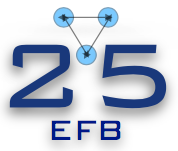Speaker
Description
Baryon interactions, including nuclear force, are an essential component in nuclear physics especially in studies of few-body systems. There are already some useful phenomenological nuclear forces, thanks to a lot of experimental data. While, we suffer from uncertainty in hyperon interactions due to a lack of experimental data. In such case, it is very useful if we could derive baryon interactions based on the QCD, the fundamental theory of the hadron world, instead of relying on experimental data. We, HALQCD collaboration, have been working toward that goal in recent years. Our method uses numerical calculations of QCD on lattice. Specifically, we measure the spatial correlation functions of hadronic few-body systems and extract potentials of interactions from them[1]. For example, we have revealed flavor-spin structure of baryon interactions and existence of H-dibaryon in flavor SU(3) symmetric world[2]. We have just extracted all the S-wave baryon interactions from QCD at the physical point by performing a massive lattice QCD simulation on the Fugaku computer in Japan.
Recently, there was an alert about baryon interactions extracted from QCD on lattice. Namely, it was pointed out that the baryon interactions extracted from QCD on lattice strongly depend on the lattice spacing used[3]. Lattice QCD generally cannot avoid an error due to a finite lattice spacing, called the discretization error. The question is how large is its impact in baryon interactions. In response to this point, we began to study the dependence of the interactions on the lattice spacing. We have performed calculations on three different lattices with different lattice spacing for the same quark mass. We will report our results in detail at the conference.
[1] N. Ishii, S. Aoki, and T. Hatsuda, Phys. Rev. Lett. 99 022001 (2007)
[2] T. Inoue etal. (HAL QCD Collaboration), Phys. Rev. Lett. 106, 162002 (2011)
[3] J. R. Green, A. D. Hanlon, P. M. Junnarkar and H. Wittig, Phys. Rev. Lett. 127, 242003 (2021)

